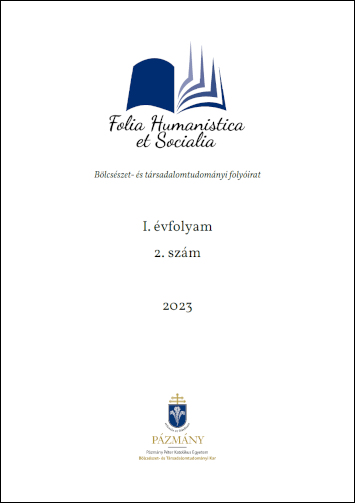Esther Greenwood, mint az „őrült nő”: A kapcsolat a patriarchátus, a nőiesség és a megbélyegzett női mentális betegségek között Sylvia Plath Az üvegbura című művében
Megjelent 2023-12-31 — Frissítve ekkor: 2024-06-11
Copyright (c) 2023 Tóth Tamara

This work is licensed under a Creative Commons Attribution 4.0 International License.
Absztrakt
A cikk központi témája Sylvia Plath The Bell Jar [Az üvegbura] című műve, amely rávilágít olyan rendszerszintű problémákra és ideológiákra, amelyek meghatározták az 1950-es és 1960-as évek amerikai társadalmát, hozzájárulva a nemek közti egyenlőtlenséghez. A regény által körbejárt társadalmi problémák nagy része még ma is jelen van a nyugati kultúrákban, ezért a mű nem csak szubjektív, de univerzális női tapasztalat ábrázolásaként is értelmezhető. Plath hősnője, Esther Greenwood útja szorongáson, depresszión, öngyilkossági kísérleten és sokkterápián át vezet a gyógyuláshoz. A regény részletesen bemutatja azt, hogy melyek azok az őt körülvevő tényezők, melyek negatívan hatnak mentális egészségére. A cikk célja, hogy Esther történetét elemezve körbejárja a női szexualitást, önrendelkezést és mentális betegségeket megbélyegző, egyenlőtlen rendszert fenntartó világszemléletet, ezáltal rámutatva a mentális betegségek és a társadalmi elnyomás közötti kapcsolatra.
Hivatkozások
- Birmingham Feminist History Group. (2005). Feminism as Femininity in the Nineteen Fifties? Feminist Review, 80, 6–23. https://www.jstor.org/stable/3874362
- Coyle, S. (1984). Images of Madness and Retrieval: An Exploration of Metaphor in The Bell Jar. Studies in American Fiction, 12 (2), 161-174. https://doi.org/10.1353/saf.1984.0027
- Dowbnia, R. (2014) Consuming Appetites: Food, Sex, and Freedom in Sylvia Plath’s The Bell Jar. Women’s Studies, 43(5), 567-588. https://doi.org/10.1080/004978878.2014.914392
- Espinosa, M. (2021). The Male Gaze and Intersectionality in The Bell Jar by Sylvia Plath and The Handmaid’s Tale by Margaret Atwood. [Honors Thesis]. Florida State University Libraries.
- Friedan, B. (1963). The Feminine Mystique. W. W. Norton.
- Ghandeharion, A. (2015). Sylvia Plath’s The Bell Jar: a Mirror of American Fifties. A Biannual Publication on the Study of Language and Literature, 17(2), 64-70. https://doi.org/10.9744/kata.17.2.64-70
- Millett, K. (1970). Sexual Politics. Doubleday.
- Möller, F. (2002). Inventing Madness: A Feminist Reading of Sylvia Plath's The Bell Jar and Susanna Kaysen's Girl, Interrupted. [Master’s degree]. Högskolan i Halmstad.
- Moi, T. (1985). Sexual/Textual Politics. Meuthen & Co. Ltd.
- Morantz-Sanchez, R. (1987) Consolidating the Spheres: Exploring the History of Twentieth Century American Women. Reviews in American History, 15(4), 674–79. https://doi.org/10.2307/2701948
- Mulvey, L. (1975). Visual Pleasure and Narrative Cinema. Screen, 16(3), 6– 18. https://dx.doi.org/10.1093/screen/16.3.6
- Noriko, M. (2018). Feminine Failure and the Modern Hero: Mad Women in Sylvia Plath’s The Bell Jar and Joan Didion’s Play It As It Lays. Review of Japanese Culture and Society, 30, 71–83. https://doi.org/10.1353/roj.2018.0005
- Paley, F. Y. (2019). Stressed, Depressed, and Sexually Repressed: Patriarchy and Depression in The Bell Jar. [Honors Thesis]. Stern College for Women, Yeshiva University.
- Perloff, M. G. & Plath, S. (1972). A Ritual for Being Born Twice: Sylvia Plath’s ‘The Bell Jar.’ Contemporary Literature, 13(4), 507–22. https://doi.org/10.2307/1207445
- Plath, S. (1963). The Bell Jar. Heinemann.
- Sakane, Y. (1998). The Mother, the Self, and the Other: The Search for Identity in Sylvia Plath’s ‘The Bell Jar’ and Takahashi Takako’s ‘Congruent Figure.’ U.S.-Japan Women’s Journal, 14, 27–48. https://www.jstor.org/stable/42772124
- Showalter, E. (1992). Killing the Angel in the House: The Autonomy of Women Writers. The Antioch Review, 50(1/2), 207–20. https://doi.org/10.2307/4612511
- Skomp, E. (2003) Misogyny, the Male Gaze, and Fantasies of Female Death: ‘Eto Ia, Edichka and Russkaia Krasavitsa. New Zealand Slavonic Journal, pp. 137–42. https://www.jstor.org/stable/40922148
- Séllei, N. (2003). The Fig Tree and the Black Patent Leather Shoes: The Body and its Representation in Sylvia Plath’s ‘The Bell Jar.’ Hungarian Journal of English and American Studies (HJEAS), 9(2), 127–54. https://dx.doi.org/10.2307/41274242
- Woolf, V. (2021). The Death of the Moth and Other Essays. Rare Treasure Editions. Kindle Edition.
- Whittier, G. (1976) The Divided Woman and Generic Doubleness in ’The Bell Jar.’ Women's Studies, 3(2), 127-146. https://doi.org/10.1080/00497878.1976.9978383

